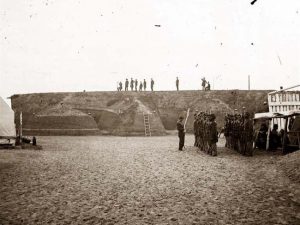CONFEDERATE DEFENDERS OF CHARLESTON MONUMENT AT WHITE POINT GARDENS
Posted By : manager
Posted : March 1, 2022
Millions of people touring Charleston over the years have enjoyed the beautiful and scenic view of the harbor and enjoyed the shade of White Point Gardens. Most have stopped to read the inscriptions of the various monuments there, the most prominent being the “Defenders” monument. This incredible work of art is an acknowledgment of the heroism of those defending Fort Sumter successfully against Union threats from 1863 to 1865, a feat worthy of the highest respect from those familiar with its story.
The monument was several years in planning and fund-raising. Native Charlestonian Andrew Buist Murray (1844-1928) bequeathed the City of Charleston $100,000.00 in his will for the monument, thus ensuring its completion and placement. Murray, orphaned as a youngster, served in a fire engine company during the WBTS, often called on for military service all around Charles-ton. Twice he served on the lines at James Island and was under fire numerous times. His postwar career, “Defenders Monument,” as a businessman brought him the great wealth he generously shared. In his lifetime, he donated over a million dollars to the city, The Citadel, College of Charleston, the Seaman’s Home, and numerous other recipients, both public and private.

The monument was officially unveiled and presented on October 20, 1932. The Charleston News and Courier had its story on the front page the next day. Over 8,000 people were in attendance. The report stated, “Many presents had fathers, uncles, and grandfathers who had fought in the…war”. The Corps of Cadets from The Citadel was present along with the Sumter Guards and the Washington Light Infantry. Among the special guests and speakers was William Robert Greer, a Charleston resident and the last living Confederate veteran of Fort Sumter. Greer served as a private in Company B {Washington Light Infantry}, 25th SC Infantry, and was at Battery Wagner as part of its last garrison before it was evacuated September 7, 1863. He & his company became part of Sumter’s garrison for about 30 days in October and endured the initial stages of the Second Great Bombardment of the fort. He returned for another stint there in February 1864. A true and faithful soldier, he was captured at Fort Fisher, NC, in January 1865 but survived Elmira POW camp until release the following June.
When the army evacuated Charleston in February 1875, Sumter’s final Commander, Captain Thomas A. Huguenin, carried the last Confederate flag to fly over the fort with him. Passed along to the Sumter Guards for posterity purposes after the war, it was presented and used in the monument dedication. However, the actual unveiling was performed by “four young ladies, all descendants of members of the Confederate garrison of the fort.” One was the granddaughter of Colonel Alfred Rhett, the first commanding officer. Another was the granddaughter of Captain Huguenin, and another was the granddaughter of Major John Johnson, the premier Engineer at Sumter in its darkest days. The fourth lady was a grandniece of General Stephen Elliott, the fort’s second commander. These officers are credited with inspiring leadership in difficult times and earned great acclaim for their service at the defense.
The “Defenders” monument was presented in the early years of the Great Depression. Intend-ed to provide recognition and respect for those who endured so much in defense of Fort Sumter, it has served as an inspiration to later generations. Its dedication was meaningful to the city and its residents then and remains so today.